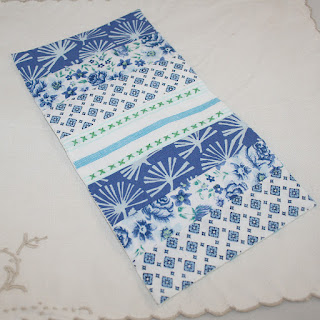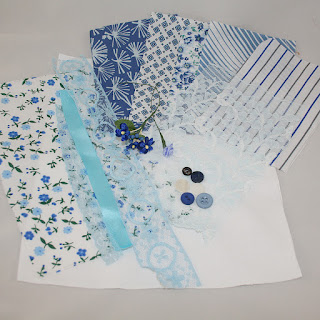The following materials from the pack are needed:
In addition, you will need scissors, a needle, a 'circular template' (for example a cotton reel) and a pencil.
Measure the dimensions of the aperture card (when folded as if completed). From the plain fabric cut a panel about 1 cm shorter and 1 cm narrower than the folded card. Fold the fabric in half to find the centre line:
Using the pencil, draw a half circle lightly on the fabric, positioned just below the vertical centre mark and take care to keep it central from left to right.
Using a fancy yarn from the pack, fill in the 'bowl' shape with a 'zig-zag' of couching - small over-stitches in the fine sewing thread provided, over the laid out fancy yarn to anchor it in place:
When the bowl shape has been filled cut off the remainder of the fancy yarn, leaving a 3 or 4 cm tail. Double this tail back into the bowl shape and couch in place. Repeat with the tail from the start of the couching.
Using the Contrast thread 1, work an outline to the bowl - I have used chain stitch - back stitch would work just as well.
Continue with the same contrast thread and start to work a posy of simple flower shapes above the bowl, using lazy daisy stitch as shown. There should be sufficient thread for about 6 small flowers. Some of these should be stitched in the main sewing thread from the pack.
Work french knots, or small cross stitches, for the centre of each flower - choosing the contrast thread for flowers stitched in the main colour and vice versa.
Using the second contrast thread, work some further daisy stitches as leaves.
Assemble the card using the double sided adhesive provided. Using the squares on the backing paper as a guide cut 2 strips 0.5 squares wide by 4.5 squares long. Cut each of these 2 strips in half to result in 4 strips 0.5 x 2.25 cm. Peel the backing from one side of the adhesive and stick the four strips around the aperture ON THE INSIDE of the card - as shown:
Remove the remaining backing paper. Place the embroidered design face up on a flat surface (press carefully first if necessary). View the design through the card aperture - holding the card right side upwards with the adhesive strips towards the embroidery. When you are happy that the design is correctly positioned in the aperture, lower the card onto the fabric and carefully press around the edge of the aperture to secure the adhesive.
Cut the remaining adhesive into three strips, 0.5 squares wide by 4.5 squares long. Remove the backing from one side of the adhesive and position the strips on the inside of the card on the three 'open' sides of what will become the 'lining' to the design.
Remove the remaining backing paper and carefully press the card closed.
The purse and bookmark may also be made from the Inspiration Pack. You can find the instructions in two other blog posts:
Coin Purse
Book Mark
The pack also contained these additional fabrics, trimmings and embellishments. I wonder what you would make with them?

















































